Performance: RAID 5
To build our RAID 5 array we decided upon a stripe size of 128KB, as this stripe size allowed for good performance in both the Adaptec and Promise hardware RAID cards tested. Like we did in the above performance analysis, we will again use bar graphs of the workstation access pattern at a medium I/O load to compare the performance of the cards. Also thrown into the set is our standard IDE drive.
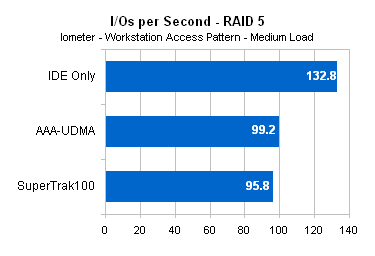
At the beginning, while discussing RAID 5, we mentioned some performance issues that may come from using RAID 5: mainly that every write requires at least 2 reads and 2 writes. Well, as you can see, this plays a role in the performance of RAID 5, at least in our I/Os per second benchmark. Both cards performed significantly worse than the single IDE drive, with the Adaptec card performing 4% faster than the Promise card.
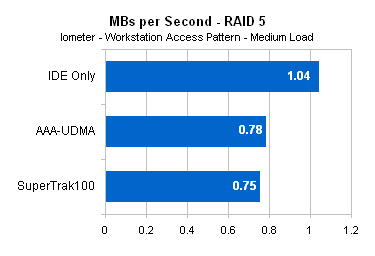
The story remains the same with the MBs per second results. Once again although both RAID 5 configurations perform worse than the single IDE drive, the Adaptec card holds a 4% performance advantage over the Promise offering.
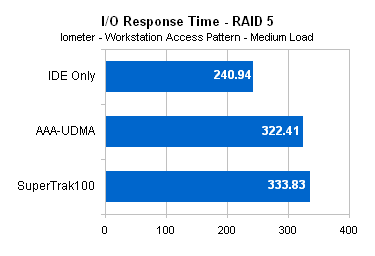
The I/O response times show the same results, with the Adaptec card performing about 4% faster again.
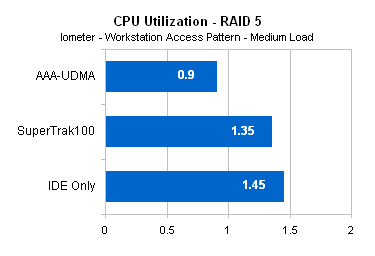
The story changes a bit when we look at CPU utilization. This time both hardware RAID cards have the advantage over the IDE drive, since all data is passing through the card and not through the system. The Adaptec card was able to use much less CPU power than the Promise card, perhaps due to its use of a SCSI to IDE converter.
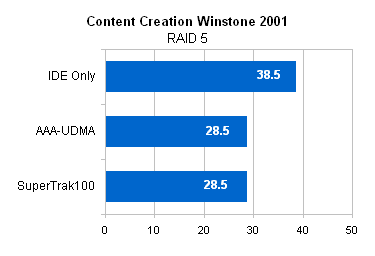
It is with the real-world Content Creation 2001 benchmark that we can really see the toll that hardware RAID takes on the system. Both hardware RAID cards ended up performing the same in this benchmark, which left them a full 35% behind the single IDE drive.
As we can see, RAID 5 should be strictly reserved in cases where data integrity is of the utmost importance. It does offer advantages over a RAID 1 solution, as the array makes use of more hard drive space and has extra capabilities that RAID 1 can not offer. But with the rather noticeable performance hit that RAID 5 incurs, this RAID type is best left for servers with critical data but not much need for speed.
The other RAID type that offers some form of security is RAID 1. We will take a look at this RAID type next.










2 Comments
View All Comments
kburrows - Thursday, December 4, 2003 - link
Have you run any tests on any onboard RAID solutions for RAID 0 & 1? I would love to see the results posted for the new SATA RAID on the Intel 875 boards.Anonymous User - Sunday, August 17, 2003 - link
In adressing the performance of an raid array with different stripe sizes, you miss an important factor, namely the accestime of an disk. This wait time has two main couses. First the head positioning and second the rotational latency (the heads track the right trace, but position where the read start has not passed under the head). You may have to wait from 0 to (in the worst case) a full cycle.Since the disks move independently You can calculate that the average latency to get an small file is minimal when the stripe size is about an full cycle of an disk in the array (aprox. 250kB today). All other factors I do know do not reduce this. (controller overhead, transport,...)
So I think that today a minimum stripe size of 256kB should be used.